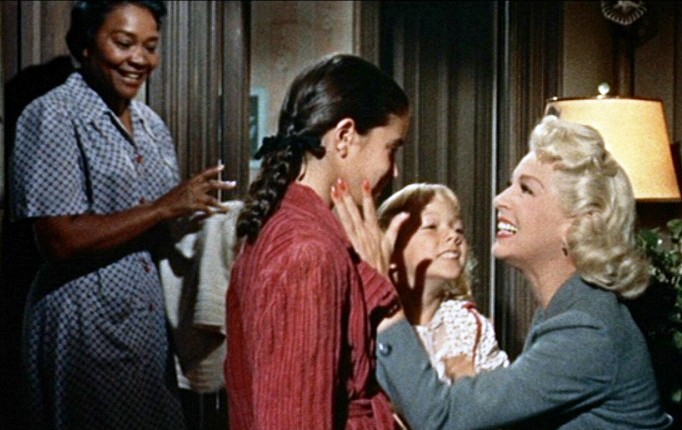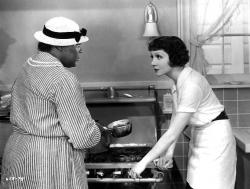This week we celebrated one of the most fundamental
and complex relationships; that which exists between mothers and their
children. Often idealized as a combination of love, duty, and sacrifice, even
the healthiest of mother-child relationships are subject to misunderstandings,
unreasonable expectations, and disappointments. The contradictory nature of
motherhood was so expertly captured in the Fannie Hurst novel Imitation of Life that the story was
adapted into, not one, but two classic films. Although released in two very
different eras, both films challenge social, gender, and race relations, but
the crux of both stories remains the enduring friendship between two women and
their complex relationships with their daughters. This week’s review will focus
upon the ways that these films reflect their respective eras, and the ways in
which their shared message of understanding, tolerance, and acceptance
continues to resonate today.
The
Mothers: Although promoted as a mother-daughter story, one of
the greatest strengths of both films is the friendship and working
relationships between its mothers. In the 1934 version, Bea (Claudette Colbert)
is a recent widow struggling to raise her young daughter amidst the upheaval of
the Great Depression. Delilah (Louise Beavers) is a fellow single mother trying to raise a
daughter alone after her husband walks out on their family. Together, the pair
make a mutually beneficial deal; Delilah will work maintaining the house and
babysitting Bea’s daughter during the hours Bea is out seeking employment in exchange
for room and board. Similarly, in the 1959 version Lora (Lana Turner) is a struggling widow
and aspiring actress who hires recent divorcee, Annie (Juanita Moore) to manage her house and
babysit her daughter, Susie, while she seeks acting work. In both films the
women become fast friends and rely upon one another’s help as they endure the
ups and downs of life as working mothers.
While both films showcase strong relationships between
their heroines, they also highlight the racial divisions that continue to exist
between the characters in spite of their friendship. In the 1934 film, Bea and
Delilah work together to form a pancake mix business using Delilah’s recipe and
Bea’s business acumen. Despite their mutual efforts, however, Bea only offers
Delilah twenty percent of the profits. The situation then becomes even more unequal
when Delilah flatly refuses her share in a scene that today plays awkwardly at
best, and Bea still goes on to use Delilah’s image as an Aunt Jemima-esque
mascot for the brand. The continued inequality between the two in spite of
their mutual venture and friendship is superbly captured in a shot in which the
two share a heartfelt moment, only to part with Bea going upstairs to her room
and Delilah exiting downstairs to hers. While
the relationship between Lora and Annie is equally poignant, the racial
tensions between them are more subtly incorporated, with Annie continuing her
role as devoted housekeeper as Lora embarks upon a glamorous career as a
Broadway star. While the opulence of the 1959 version is pleasing to the eyes,
Lora’s stage success is far less relateable than Bea’s struggle to start her own
business, and the stakes of Lora chasing her dream pale in comparison to Bea’s
need to support herself and her daughter during the Depression. As a result,
while the 1934 version is a grittier and more realistic tale of working class
America as opposed to 1959’s glamorous tale set in the post-war boom, the 1959
version reflects the advances of the civil rights movement that were beginning
to take root by the late 1950’s.
The
Daughters: One of the most crucial strengths of the
original story and both adaptations is the depth with which the two very
different daughters are portrayed. In both films the African American mother
Delilah/Annie becomes estranged from her daughter Peola/Sarah Jane (Fredi Washington and Susan Kohner) after the
daughter attempts to ‘pass’ in white society. In the 1934 version, Peola’s
rejection of her race is portrayed as a rejection not of her mother or heritage,
but as a rejection of the limitations society places upon her because of her family and heritage.
Rather than using the temporary freedom afforded her by her lie to pursue any
lofty dreams, Peola settles for an entry level job in a small town with the hope
of working her way up to a moderate success. The fact that Peola sacrifices her
family for such a modest path serves to remind viewers of just how limited her
options for finding a better life as an African American would have been during
that time. In the 1959 version, Sarah Jane also attempts to ‘pass’, but over
the course of the film her motives become murky as she strives for a
show-business career reminiscent of Lora’s success, and is portrayed as hungry
for fame rather than merely desperate for a better life. The 1934 film also
conveys a greater sense of authenticity through its casting choice of a black
woman in the role of Peola, while the 1959 version fails to suspend audience
disbelief through its casting of a hispanic actress in the part. In both films,
however, Peola and Sarah Jane defy stereotypes through their portrayal as
complex women who want to live life on their own terms, rather than those set
down for them by society.
Similarly, both films feature a common dilemma for
Susie and Jessie (Sandra Dee and Rochelle Hudson), who are both alienated by their mothers’ dedication to their
respective careers. As a result of their isolation, both girls seek affection
in surrogate father figures in the form of their mothers’ boyfriends. In the
1934 version, Bea begins a romance while Jessie is away at college, only for
Jessie to return and develop an immediate infatuation with her mother’s beau (Warren William).
In this film, Jessie’s insistence upon maintaining her fantasy is portrayed as a
means of lashing out against her mother rather than a genuine attraction, and parallels
Peola’s rejection of Delilah. In the 1959 film, however, Susie nurses a crush
on her mother’s long-time on and off boyfriend, Steve (John Gavin), in large part because he
has been there for her more often than the jet-setting Laura. As a result,
Susie’s misplaced affection is an attempt to cry out for her mother’s love and
attention, and stands in stark contrast to Sarah Jane’s blatant rejection of
Annie. One of the most emotional moments in the 1959 film explores this
contrast by showing the way that Susie and Annie turn to each other for comfort
as they face estrangement from their own families. This scene also reminds
audiences of the ways in which racism can be overcome, as both women find the
solace that they need in their surrogate families outside of their own race.
Despite their different approaches, both films reveal the ways that a lack of
love and guidance, even if unintentional, can impact and skew a person’s
understanding of the world around them, and highlights the fundamental need of
all children for their mother’s love. Indictment of injustice, family drama,
and tale of friendship, are all phrases that aptly describe the tribute to the
very real triumphs and struggles of motherhood that is Imitation of Life.
 |
| Now in glorious technicolor! |



No comments:
Post a Comment